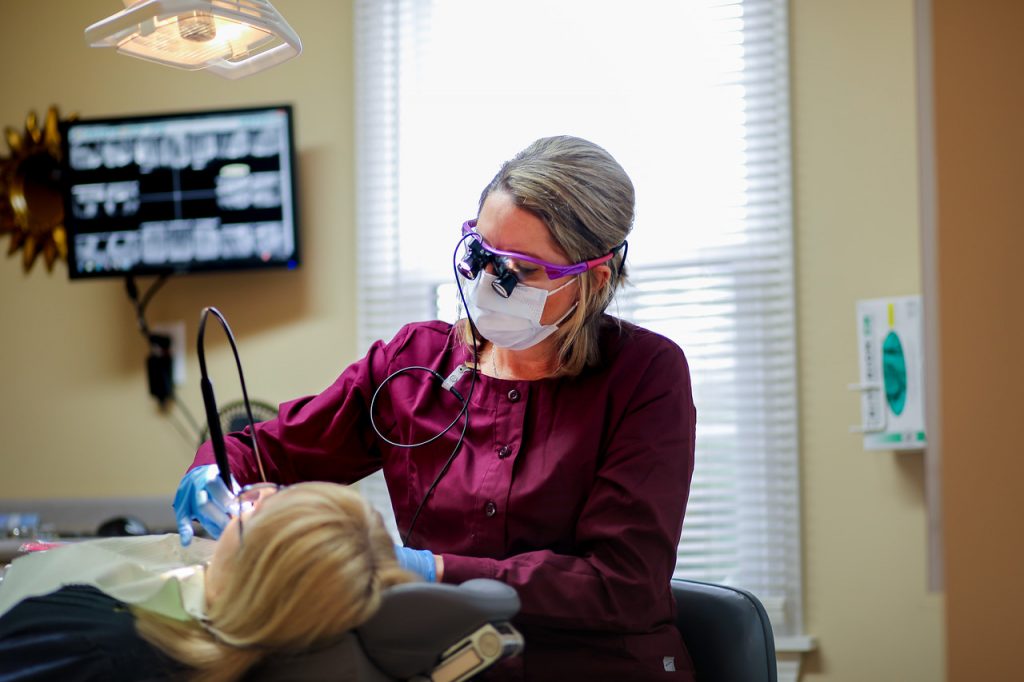WEAR YOUR MOUTHGUARD!!
February 26, 2020

Mouthguards are nothing new, but there are still far too many sports related injuries. Although most youth sport organizations have cracked down on making kids wear mouth protection, there are still injuries occurring. Taking the appropriate protective measures while on the court, field, rink, or ring can save mouths from serious injury and costly dental repairs.
Any sport that presents the chance of contact or collision with another person, object, or surface can potentially cause injury to teeth, jaws, and oral soft tissue. These sports include, but are not limited to, football, basketball, soccer, hockey, boxing, and lacrosse. Individuals who participate in sports, such as biking, inline skating, or skateboarding are also at risk for injury.
Teeth get in the way. Other than your nose, front teeth are “out there” and your lips only provide minimal protection. For example, a student I saw this past spring was injured playing squash at a local private school. Squash is a non-contact sport, but the game is played in close proximity to another player with a swinging racquet. The student I treated had been hit in the mouth with the other player’s racquet. He required a root canal on one front tooth with a crown. The other front tooth needed to be extracted and replaced with a dental implant. All of this could have been prevented or at least damage lessened with the use of a mouthguard.
For some reason, baseball is one of those sports where kids do not wear protective mouthguards. No matter what age level, a player can misjudge a ball or a ball can take an unexpected bounce, causing serious injury.
In lacrosse, both boys and girls should always be wearing mouth protection. That ball is extremely hard and heavy. Boys are better protected than girls because they at least wear helmets; both should be wearing helmets, in my opinion.
A custom mouthguard made by your dentist covers the upper teeth with a soft, flexible material that prevents serious injuries such as broken teeth, jaw fractures, cerebral hemorrhage, and neck injuries. It decreases the chance of the lower jaw jamming into the upper jaw or being pushed back into the temporomandibular joint (TMJ). Mouthguards may reduce the severity and incidence of concussions as well.
Custom mouthguards, made by a dentist, fit 100 times better than anything you can buy in a store. This not only improves performance (making it easier to breathe), but also makes it more likely the athlete will keep the mouthguard in. They may cost more than the boil/bite generic ones, but they are better, and that is enough reason to consider them.
If you seek treatment immediately after the injury occurs, your dentist often can save knocked-out teeth and repair minor chips and cracks with appropriate dental materials. See your dentist for evaluation if your tooth changes color, if you experience any pain, or if you notice any swelling in or around your mouth following trauma.
Even if it isn’t “cool” to wear a mouthguard in the sport you are playing, I strongly recommend it. You only get one set of your own teeth.
Dr. St. Clair maintains a private dental practice in Rowley and Newburyport dedicated to health-centered family dentistry. If there are certain topics you would like to see written about or questions you have please email them to him at jpstclair@stclairdmd.com. You can view all previously written columns at www.jpeterstclairdentistry.com/blog.
BEYOND TOOTH PAIN
February 24, 2020

Orofacial pain includes a number of clinical problems involving the chewing (masticatory) muscles or temporomandibular joint (TMJ). Problems can include TMJ discomfort, muscle spasms in the head, neck or jaw, migraines, cluster or frequent headaches, pain with the teeth, face or jaw, anxiety and depression.
The resting position of the jaw, which is the position it should be in most of the time, is lips together with the teeth slightly separated. Breathing should be through the nose. The teeth should be touching a total of about 15 minutes in a 24-hour period of time. People who clench or grind touch their teeth much more than this. This is the primary reason people get orofacial pain. Pain can also be caused by things like trauma to the head and neck or poor ergonomics (posture).
Temporomandibular disorders (TMD) affect more than 10 million Americans. Your TMJ’s are located where the skull connects your lower jaw to the muscles on the sides of your head and face. They control the joint’s movements. Women between the ages of 20 and 40 are the most frequent sufferers of orofacial pain due to added estrogen in their bodies. Estrogen impacts the body’s natural pain fighters (endorphins), increases inflammation in the temporomandibular joints, and compromises the strength and adaptive ability of all ligaments.
One in eight Americans suffer from headaches. Experts estimate that 80 percent of all headaches are caused by muscle tension, which can be related to the bite. Clenching the jaw muscles creates tension in the muscles that close the jaw, the main one of which is the temporalis muscle. Signs that may indicate a headache from dental origin include: pain behind the eyes, sore jaw muscles or “tired” muscles upon awaking, teeth grinding, clicking or popping of the jaw joints, head and/or scalp is painful to the touch, earaches or ringing, neck and/or shoulder pain, and dizziness.
Sleep disorders can also play a role in orofacial pain. If you have gone through treatment for orofacial pain and still experience problems, it is possible that a sleep disordered breathing problem such as sleep apnea could be contributing. People who have problems like this will often exhibit jaw pain due to the body moving the jaw around at night to get better air flow. Patients have no idea this is occurring usually until they wake with sore jaw muscles. Treating the sleep issues usually solves the jaw issues.
If the orofacial pain is not related to sleep, there are a variety of treatments that can help relieve symptoms. One device is called an orthotic, or splint, that is worn over the teeth to help stabilize the bite. Permanent correction may sometimes require equilibration (reshaping teeth), orthodontics or a combination of these and other restorative dentistry. Many use a splint (day and/or night) on a daily basis to avoid having these other treatments done.
Other things that can help alleviate pain are using ice on the painful area, eating a softer diet and avoiding chewing gum or ice. It is important to be conscious to keep teeth slightly apart except when chewing and swallowing. Use of anti-inflammatories is okay to use if it is an acute short-term problem. Chronic problems are best treated by determining and treating the source.
Orofacial pain can range from tolerable to debilitating. Most of these problems can be corrected and/or managed. If your dentist can not help you, ask for a referral to a specialist.
Dr. St. Clair maintains a private dental practice in Rowley and Newburyport dedicated to health-centered family dentistry. If there are certain topics you would like to see written about or questions you have please email them to him at jpstclair@stclairdmd.com. You can view all previously written columns at www.jpeterstclairdentistry.com/blog.
DENTAL DIFFERENCES
February 18, 2020
Let’s use this hypothetical situation: You have not been to a dentist in a while (pick a time frame), you are well aware you need some dental work, you were given the recommendation of a dentist by a friend…..and, you decide to visit that dentist and four other dentists to compare and make a decision who is the best fit for you. (I realize that most people don’t want to and/or don’t have the time to visit five dentists….but play along).
You already have an idea of what you are looking for. It might be the dentist who says you need the least. It might be the dentist who is the cheapest. It might be the dentist who is closest to where you live. It might be the dentist who gives you the most options, or maybe the least. It might be the dentist who listens to you the best. Be prepared, because you are likely to hear a few different styles/opinions visiting five dentists.
Some practices may feel “clinical and efficient”, while others feel somewhat more home spun and laid back. The dentist’s personality and experience are reflected in his or her treatment preferences as well. The fact that different dentists will suggest different plans to treat your condition does not necessarily mean that one plan is better than another. Have an open mind and play an active role in the treatment planning process.
It is important to remember that there are numerous ways to treat the same situation, and it is always important for the dentist to tailor the treatment plan for each patient’s specific circumstances. A major part of those circumstances may be financial, and since different treatment plans can vary a great deal in cost, it is important for the dentist to discuss costs and options for payment.
Think of treatment plans like various models of cars offered by different dealers. All of the models are new, have warranties and will work well out of the lot. The higher end models, however, have some advantages not found in the less expensive models. Some options add years to the life of the car. Some add to the appearance and enjoyment of driving it. Having said that, dentistry is not a commodity. There are many factors that need to be taken into consideration when choosing your provider or the treatment you choose for yourself.
What makes sense for you? What are your objectives? Saving a badly damaged tooth with a root canal and a crown may preserve it for a long time, but what are the circumstances of how the tooth got to that point? If you haven’t been to a dentist in many years and have many other dental needs, does it make sense?
We have so many great dental providers in our area. Think about what you are looking for in a dental care team Read that list in the second paragraph again.
The focus should be on long-term objectives and prevention. If you are a regular dentist-goer and have a dentist you like, you’re all set. If you haven’t been in a while, consider making the decision to change how you look at your dental health. Start with finding a place that fits your particular needs, and make the commitment to make routine preventive dental care part of your life.
Dr. St. Clair maintains a private dental practice in Rowley and Newburyport dedicated to health-centered family dentistry. If there are certain topics you would like to see written about or questions you have please email them to him at jpstclair@stclairdmd.com. You can view all previously written columns at www.jpeterstclairdentistry.com/blog.
DENTAL X-RAYS
February 10, 2020

Here are a few common questions and answers regarding dental radiographs:
I had a dental x ray while I was pregnant. I am worried that my unborn child might have been exposed to the radiation. Can you please tell me if there are any risks to my baby from this?
There is no information suggesting any risk to an unborn child from dental x-rays received by the mother. We were taught in dental school to avoid dental x-rays on pregnant patients. However, with newer technology the radiation dose to the fetus is insignificant. Prudent practice would dictate limiting x-rays on pregnant women, but there is absolutely no harm in taking x-rays if needed to diagnose a problem.
Is there residual radiation in a room after a dental radiograph has been taken?
X-rays cease to exist when the machine is switched off, much like the light from a light bulb when it is turned off. No residual radiation remains.
How much has dental x-radiation been studied and how concerned should I be about having dental x-rays done? Is there a limit on how many I can have?
We now have very complete information on patient radiation doses from dental x-rays. They are among the lowest radiation dose exams of any diagnostic radiologic procedure in the healing arts. Current practices deliver patient doses from a full-mouth series of intraoral films (usually 14-18 films) that are less than what a person receives in a month from natural environmental sources (commonly called background exposure). Doses from bitewing or panoramic films are even less. New technology is reducing the doses still further. There is no limit on how many dental x-rays you can have. The decision to have a dental x-ray is based on the benefit of knowing whether or not there is a cavity, crack, or some other abnormality. So the decision to have them is based on what you and your dentist think.
I recently had some dental x rays and the operator forgot to place the lead apron on me. Is this a problem?
Use of the lead apron to protect the patient undergoing dental radiographic examination was recommended some 50 years ago, when equipment was crude. This was because x-ray beams were not restricted to the area of clinical interest, beams were not filtered, and x-ray film was slower, causing radiation exposures 10 to 100 times higher than received today. With the current technology reducing radiation exposure significantly, and the beam limited only to the area of interest, there is little or no measurable difference in whole-body dose whether a lead apron is used or not. The lead apron is no longer regarded as essential although some consider it a prudent practice, especially for pregnant and potentially pregnant females.
If you have any other questions on dental x-rays, please e-mail them to me.
Dr. St. Clair maintains a private dental practice in Rowley and Newburyport dedicated to health-centered family dentistry. If there are certain topics you would like to see written about or questions you have please email them to him at jpstclair@stclairdmd.com. You can view all previously written columns at www.jpeterstclairdentistry.com/blog.
Is There a Link Between Gum Disease and Heart Disease?
February 6, 2020

Since February is the month of love, now seems like as good a time as any to talk about your heart. More specifically, how your gums can affect your heart. If you have periodontal disease, also known as gum disease, that puts you more at risk of developing cardiovascular problems. Why is that? A dentist is here to explain the gum-heart connection and what it means for you.
(more…)DIABETES & DENTISTRY – PART 2
February 3, 2020

Last week I discussed the role and effect that diabetes has on oral health. It is not something that should be taken lightly. If you missed this column, please visit the website at the end of this column or e-mail me directly and I will send you a copy.
After reading last week’s column, it may seem frightening that there is no way out of the partnership of horrors between diabetes and severe gum disease. There are solutions. Just as poor oral health can compound a diabetic’s situation, proper oral health can come to the rescue.
Clinical studies confirm that treatment of gum disease reduces oral inflammation, which removes the factor that triggers the body’s inflammatory response which, in turn, plays a major role in compounding the effects of diabetes. Dental treatments that fight gum infections also help improve control of blood sugar levels in diabetics.
If you are pre-diabetic, your dentist may actually be able to help prevent diabetes. If you already have diabetes, your dentist may be able to help you keep it under control, improve your quality of life, and reduce the risk of premature death.
There’s even better news. It’s never too late to improve oral health care. Even if you already have severe gum disease or other dental problems, proper treatment can help stop it in its tracks. In many cases, dentists can even reverse the damage done to your teeth and gums as well as manage the metabolic elements of diabetes. And, if you haven’t yet developed any symptoms of diabetes-related oral health problems, your dentist can start a prevention program that will help you stay in control of your diabetes, maintain better health and enjoy a preferred quality of life.
Perhaps the best news is that this is something that doesn’t require exercise, taking a pill, giving yourself a shot of insulin, or sticking to a special diet. However, some or all of these things may be necessary to also help control diabetes. From an oral health perspective all you need to do is to start seeing your dentist and talking to him or her about your particular situation.
When it comes to partnering with you to manage the oral health issues in regards to diabetes or pre-diabetes, there are going to be varying degrees of participation from dentists, depending on their knowledge or “philosophy” of care. The best team approach is between the doctor, the patient and the dentist. If one of these team members does not participate, the battle cannot be won. Often times, it is the patient who is not doing the things that he or she needs to do to properly manage the problem. If the dentist does not seem too concerned about your diabetes and you have the desire to have your oral health properly managed and are willing to do your part, find a new dentist.
The point is that this is a serious issue and if you, the patient, wants to take control of it, a team effort is needed. Find the right team. Make a commitment to improve your health and quality of life. You can do this.
Dr. St. Clair maintains a private dental practice in Rowley and Newburyport dedicated to health-centered family dentistry. If there are certain topics you would like to see written about or questions you have please email them to him at jpstclair@stclairdmd.com. You can view all previously written columns at www.jpeterstclairdentistry.com/blog.







